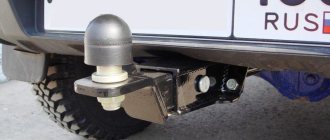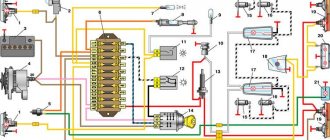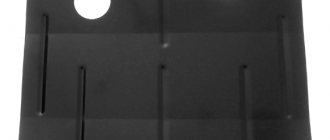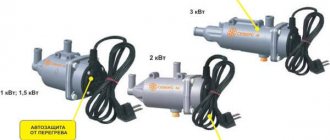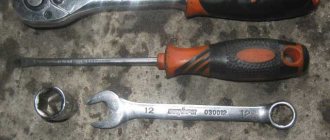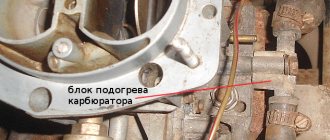Winter is a challenge for any car owner. Moreover, many are annoyed not so much by the deterioration of the road situation (snow, ice), but by the difficulty of starting a cooled power plant. Of course, those whose cars “winter” in heated garages do not have this problem, but there are relatively few of them. Most car owners have their cars idle overnight in the open air or in a regular garage (at best).
And yet there are ways to alleviate the plight of car owners. One of the most optimal methods now is to install a heater on a VAZ or any other car.
Preheater
The problem of difficult starting of a power plant in winter is associated with several factors - the viscosity of the oil increases, the resistance in the battery increases, and it is no longer able to produce good starting currents. As a result, when trying to start, the starter “lazy” turns the crankshaft, and the rotation speed is clearly not enough to start the engine. And only after a couple of attempts, when the oil is mixed a little and the battery “warms up”, the engine can still be started, but this does not always happen.
Note that the chances of a successful start in cold weather are also affected by the technical condition of the power plant and the degree of its wear. Thus, the probability of owning a VAZ of the classic family (2101, 2106), produced 30-40 years ago, is significantly lower than a relatively new car. But installing a heater on a VAZ-2101 increases these chances, and significantly.
As noted, the difficulty of starting the power unit is largely due to the solidification of working fluids. But if you warm them up before starting, then the resistance that they create due to the increased viscosity will not exist, and it will be much easier for the starter to turn the crankshaft. It is precisely the preheating of the engine that is the task of the heater.
This device, in principle, is universal, so you can easily install a preheater on a VAZ, UAZ or any other make of car.
Types, features of work
There are several options for such equipment, but in essence such a device is a conventional electric heating element that provides heating of one of the fluids of the power unit.
There are several types of heaters. Some of them heat antifreeze, others heat oil. In the case of coolant, by acting on antifreeze, it is possible to heat the cylinder block, as well as the elements of the power system, which is important for ensuring normal mixture formation.
But such a device has disadvantages:
- it takes more time to warm up the engine, since the cooling system is just a shell of the cylinder block;
- the oil heats up slightly, since it is located below the cooling jacket in the sump, so heat will flow to it only after the cylinder block has been well warmed up;
But when using such a device, there is practically no need to warm up the engine after starting, since it is already heated, and warm air is immediately supplied from the stove to the cabin.
As for heaters that act on oil, such a device only heats the lubricant; the cylinder block and power system remain cold.
Since the volume of oil is small and it is all in one place, it takes little time to warm up. But due to the fact that only the lubricant heats up, after starting it will take time to warm up the motor itself.
In general, the effectiveness of using one or another device is approximately the same. When heating the antifreeze, we get a heated cylinder block and power system, which ensures good mixture formation (the result is excellent flammability of the mixture), but cold oil (the load on the battery and starter will remain high). If you heat the oil, then everything is exactly the opposite - the starter will turn easily, but the unit itself and the power system will remain cold.
Heaters also differ according to the power source used:
- From the network 220 V;
- From the on-board network 12 V (autonomous);
The first option is characterized by high power, and therefore the speed of heating of the working fluid. But to use it, the car must be close to the outlet.
As for autonomous devices, the heating element is powered by a battery, which means you can warm up the liquid anywhere, even in the field. But they are not very powerful, and during operation they drain the battery, and if it is already on the verge of exhausting its life or is simply discharged, then there will simply be no energy left for the starter after warming up.
Antifreeze heaters operating from a 220 V network have become widespread among car owners. In general, this is one of the most optimal options - the battery does not run out, the power of the heating element is high, and after using it, the driver also receives hot air from the stove.
Now manufacturers of automotive accessories and equipment offer different models of preheaters. All of them are almost identical in operating principle, but may differ in design - some consist only of a heating element, while others may additionally have a circulation pump.
Difficult choice
To answer the question of which diesel engine preheater is best to purchase, you need to take into account various nuances. This includes the frequency of use of the vehicle, the characteristics of the vehicle itself, as well as the conditions of its operation and the service life of the engine.
If the climatic conditions are satisfactory, then there is no particular need for the device. Also, if the car is in a heated garage most of the time, then a heater is unlikely to be needed. It’s another matter if the car is operated in a harsh climate, where winters are usually long and frosty. Then the preheater will be truly in demand.
Naturally, a modern new car will easily start even in cold weather, but the wear of its engine parts will accelerate, since they are subjected to additional and heavy load. Therefore, those car enthusiasts who want their vehicle to last as long as possible should take care of it and purchase a diesel engine pre-heater.
Reviews from those who already use the device are mostly positive. Some people prefer domestically produced models, while others choose only imported ones. Both have their advantages and disadvantages.
Let's look at the brands that are most in demand among car enthusiasts.
Installation of equipment on a car
Installing a heater on a VAZ-2106 or any other model does not require any modifications to the power unit. Such equipment is external, and all that is needed is to correctly insert it into the power system.
The heater kit consists of:
- Block with heater;
- Fastening elements;
- Adapters, tees and clamps for insertion into the cooling system;
- Cable with plug.
Additionally, for installation you will also need sections of pipelines of the required length to make an insert.
There are several installation schemes for such a device, the simplest of which is shown below.
To ensure uniform heating, antifreeze must be supplied to the device from the lowest point of the engine, which is the drain plug of the cylinder block. But the exit of the already heated liquid is the opposite - to the top point.
To connect the equipment to the VAZ-2106 engine, you must:
- Install the fitting from the kit into the engine block and connect it with a pipeline to the input terminal on the heater block;
- Insert the tee from the kit into the upper pipeline of the cooling system coming from the radiator. Connect a pipeline leading to the output from the heater block to this tee;
- Attach the block with the heating element to the engine or subframe;
- Route the cable to ensure easy access to the plug.
When installing a heater, it is not even necessary to drain the antifreeze from the system. If you pre-assemble the heater (connect the pipelines to the block, tee and fitting) and quickly carry out installation work, then during operation 1-1.5 liters of coolant will leak out, which will then have to be replenished.
After installation, be sure to check all connections for leaks and, if necessary, fix them by tightening the clamps.
Installing the heater on a VAZ-2107 injector does not differ from that described above.
Security measures
Finally, a little about the safety rules when using such a preheater:
- Do not leave the equipment turned on for a long period of time. For normal warming up of the engine, 1-1.5 hours is enough;
- If an extension cord is used for connection, its wires must have a cross-section appropriate for the load;
- If the equipment is used on a car parked on the street, you need to mark or fence off the area through which the power cable runs.
For ease of use of the device, it should be connected to a power outlet through an adapter with a timer, on which you can set the time for turning the heater on and off.
Related articles:
Key characteristics of the electric heater
The main characteristics of the heating system:
- Power, measured in kW. The higher this indicator, the faster the heating of the working fluid will be in winter. For example, systems with a power of 1.5 kW allow you to warm up the refrigerant in approximately 3.5 minutes. If this parameter increases to 2 kW, the heating time will decrease to 3 minutes.
- Frequency, measured in Hertz (Hz). This indicator determines the temperature value of the thermostat activation.
- The amount of circulating flow is measured in l/sec. This parameter depends on the diameters of the inlet and outlet holes. In most modern heating systems, the lines have a diameter of 1.2 cm.
- Equipment dimensions. Depending on the manufacturer and type of device, these indicators differ. On average, the length of the device is 15 cm, and the height and width are about 9 cm.
It is important to know
Each heating system has its own degree of protection; the most common brands and models are labeled “IP 34”. This indicates that the equipment is safe to use and the possibility of a short circuit is completely excluded.
What affects power
Indicators that influence this characteristic:
- Limit frequency of equipment. This indicator is usually 50 Hz, but there may be deviations up or down.
- The diametrical size of the line, which determines the circulation rate of the heated consumable material.
- Location and correct installation. The device must be installed as firmly as possible and not subject to blowing.
Video - installing an engine heater
I came to the garage, warmed up the engine so as not to mess with the cold, and disassembled the car. Well, I took it apart and removed the air filter and battery. And I realized that on Solaris there is no drain plug or coolant in the block. I didn’t expect this, but how. I went online and found a hint that the manufacturer recommends installing the engine heater between the heater return (inlet to the engine heater) and the upper radiator hose. Well, since he recommends it, we’ll do it that way. The Operating Instructions and Installation Instructions are located on this page. The problem is to determine which of the return pipes.
I had to quickly put the car back together, but just quickly, without screwing anything in. I started it up, turned the heater on full blast, started checking the temperature of the pipes by touch, and began to doubt it. I decided not to guess, took a digital thermometer and measured it. I found out that the entrance is from below, the return is from above. The difference is only 3 degrees. I chose the installation location for the heater itself.
There was plenty of space for installation under the air filter. The place is good, in my opinion, the battery, gearbox, and air filter will heat up. Warm air always makes it easier to start. Since the coolant was strained, I decided not to spill the existing one. I cut off a half-barrel, placed it under the stove return hose, made a cut in the right place, the liquid ran out, but not much. I opened the cap where the coolant is poured, the liquid flowed out, the bottle was filled, closed the cap, the coolant stopped flowing, emptied the one and a half bottle and started again. In total, about two liters of coolant were drained. Not a drop was spilled.
I cut a 2.5 centimeter piece of hose on the stove pipe. I inserted the tee and clamped it with clamps (by the way, I changed the clamps and used my own stainless steel ones, the ones included in the kit are very weak).
I cut the upper hose from the radiator, use a sharp tool (there was no liquid there anymore), inserted a tee, and pressed it with clamps. I installed the heater itself and secured it to the screw to which the engine mass is attached. I didn’t cut the mounting plate, it doesn’t interfere, and there will be additional heat transfer. I connected everything with hoses, from the stove to the boiler inlet, the outlet to the radiator pipe. Everything, it seems, turned out not bad. I secured everything with plastic clamps, laid an electrical wire, also secured it with plastic clamps, and brought it out into the radiator grille. I had to modify it a little, cut off the protrusions on the sides of the Euro fork, everything fit perfectly.
Types of engine preheaters
First, let's define what an engine preheater is. This is a special device that heats the liquid in the car’s cooling system (antifreeze) and makes it easier to start the engine at low temperatures.
There is no need for pre-heating if the car constantly sleeps in a warm garage, and also if the winter in the region is mild and the temperature rarely drops below -5 ° C.
Preheaters differ fundamentally in their design options and power sources, and are divided into two categories:
- Electric engine preheaters are devices that operate from an external source of electricity. They are simple, therefore have a low cost, and are usually connected to a regular household outlet with a voltage of 220V.
- Autonomous engine preheaters have a more complex design, and their price is noticeably higher than electric ones. They are powered either from the vehicle's fuel system or have their own fuel tank.
Webasto or Hydronic
Those who trust only foreign manufacturers should pay attention to diesel engine pre-heaters Webasto and Hydronic. The first are represented by three models:. The first are represented by three models:
The first are represented by three models:
- E - for cars;
- C - for engines from 2200 cc;
- P - for SUVs, minivans and minibuses.
The advantages of the models include the presence of an automatic programmable timer and remote control. The disadvantages are the possible freezing of the liquid crystal screen and the high cost of the equipment.
The pre-heater for the Hydronic diesel engine is available in five modifications:
- 4 - for small cars with an engine capacity of up to two liters;
- 5 - for cars with an engine of more than two liters;
- МΙΙ - for trucks and special equipment - from 5.5 to 15 liters;
- ΙΙ Comfort – for engines from two liters;
- LΙΙ - for trucks and special equipment - over 15 liters.
The devices are capable of self-diagnosis, but their glow plugs can often become clogged, which will have to be replaced at your own expense.
DIY engine preheater
Is it possible to make an engine preheater with your own hands? The video below shows just one of these homemade products.
The fact that many do not want to spend money on installing electric engine heating and intend to do it themselves is not surprising. Russia has never complained about the lack of self-taught inventors, so there are many examples of such crafts.
Homemade heaters are made from various materials. Most often at home they try to warm up the engine with the following devices:
- based on a blowtorch;
- made of tungsten spiral;
- from wire and other improvised means.
All homemade engine heaters have two big drawbacks: they are a fire hazard (there are many cases where cars and garages caught fire due to such devices) and their low efficiency. So it’s better not to skimp on buying a high-quality preheater.
Making homemade heating
A factory-made boiler or heater is more practical and safer than one made on your own. Although the option with a homemade device also has a right to exist.
It is important to remember that when independently producing a device for heating an engine, exercise the utmost possible caution during subsequent operation. This is especially true for fire safety.
There are many options for DIYers. One example:
- in the side panel and in the bottom of the weapon casing, saw a hole for cutting a thread for a candle;
- the sleeve is connected to the suction pipe;
- installing the structure directly into the tank of the car;
- supply of on-board network cables.
The peculiarity of this installation method is that it is used to heat not the engine, but the fuel.
To avoid damage, this type of heating can be used after the engine is turned off.
Installing an engine preheater
You can install the engine pre-heater yourself, since this process does not require any special knowledge or skills. Of course, a visit to a car service center is always preferable, because there the entire range of work will be performed by professionals who will save time and also provide a guarantee for the work.
If you don’t want to take money to the station or you can’t stay without a car for a while, you can install the engine heater yourself (usually installation instructions are included in the kit).
For video instructions on how to install a 220V electric heater with your own hands, see just below. The procedure for installing the heater is as follows:
- Draining antifreeze (it must be drained up to 2 liters);
- Disconnecting the heater pipes from the engine cooling system;
- Installation of the heater and its connection to the system;
- Assembly (you need to tighten the unscrewed nuts);
- Filling with antifreeze.
The whole process will take no more than 2-3 hours.
The advantages of installing an engine preheater are obvious:
- noticeable extension of engine life;
- saving fuel while warming up the engine;
- saving time;
- environmental protection.
By the way, if you do not yet have an engine heater installed, you can read simple tips on how to start your car in cold weather.
Main advantages and disadvantages
Advantages of heating elements:
- use in any climate zone;
- low cost;
- not a complex design;
- simple diagram;
- easy installation;
- saving fuel consumption;
- reliability;
- high degree of security;
- durability;
- the battery does not lose charge;
- recharging the battery;
- ease of maintenance;
- after warming up, the starter load decreases;
- wear of parts is reduced;
- additional features will allow you to preheat the interior and eliminate icing of the windows.
The only disadvantage of such boilers is their dependence on the electrical network.
